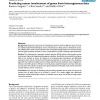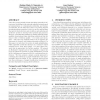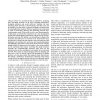60 search results - page 9 / 12 » Temporal and structural analysis of biological networks in c... |
BMCBI
2008
13 years 7 months ago
2008
Background: Structural analysis of biochemical networks is a growing field in bioinformatics and systems biology. The availability of an increasing amount of biological data from ...
BMCBI
2008
13 years 7 months ago
2008
Background: Systematic approaches for identifying proteins involved in different types of cancer are needed. Experimental techniques such as microarrays are being used to characte...
KDD
2009
ACM
14 years 2 months ago
2009
ACM
There is a growing wealth of data describing networks of various types, including social networks, physical networks such as transportation or communication networks, and biologic...
ICDE
2011
IEEE
12 years 11 months ago
2011
IEEE
—There is a growing interest in methods for analyzing data describing networks of all types, including information, biological, physical, and social networks. Typically the data ...
ISDA
2010
IEEE
13 years 5 months ago
2010
IEEE
A genetic algorithm is combined with two variants of the modularity (Q) network analysis metric to examine a substantial amount fisheries catch data. The data set produces one of t...



